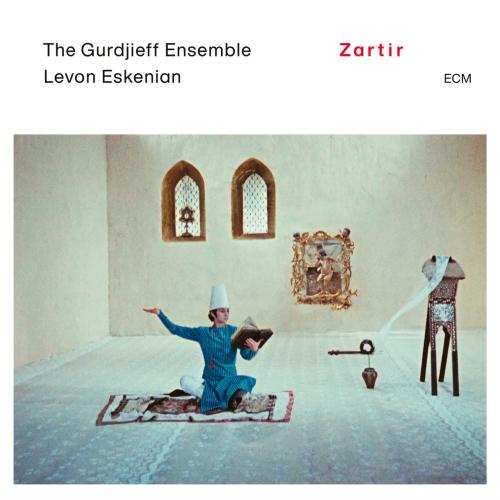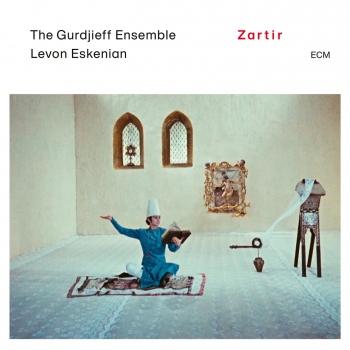
Album info
Album-Release:
2023
HRA-Release:
24.11.2023
Album including Album cover Booklet (PDF)
I`m sorry!
Dear HIGHRESAUDIO Visitor,
due to territorial constraints and also different releases dates in each country you currently can`t purchase this album. We are updating our release dates twice a week. So, please feel free to check from time-to-time, if the album is available for your country.
We suggest, that you bookmark the album and use our Short List function.
Thank you for your understanding and patience.
Yours sincerely, HIGHRESAUDIO
- 1 Pythia 03:35
- 2 No. 10 03:17
- 3 Sayyid Chant and Dance No. 41 03:15
- 4 Introduction and Funeral March 05:19
- 5 Oriental Dance 01:56
- 6 Kankaravor Enker 04:16
- 7 Dard mi ani 03:54
- 8 Thirty Gestures 01:15
- 9 Prayer and Despair 04:42
- 10 Sayyid Chant and Dance No. 42 03:39
- 11 Ashkharhes Me Panjara e 04:16
- 12 Trembling Dervish 04:24
- 13 Zartir 04:19
- 14 The Great Prayer 07:11
Info for Zartir
With his inspired arrangements for folk instrumentation, Levon Eskenian has brought about a re-evaluation of the music of G.I. Gurdjieff (ca. 1877- 1949) and given us many new insights into the sources that inspired the Armenian-born esoteric teacher, philosopher and composer.
Zartir, the third album from Eskenian’s award-winning Gurdjieff Ensemble, is its most adventurous to date, and it opens several new channels of discovery. In several pieces with a focus on the voice, it situates Gurdjieff in a tradition of Armenian ashughs, bards and troubadours including Ashugh Jivani, Baghdasar Tbir and the legendary Sayat-Nova. Gurdjieff’s father, an ashugh who performed under the name Adash, was part of this tradition, and his wide-ranging repertoire would have exposed his son, at an early age, to music and verse from many places. The texts of these songs also resonate with Gurdjieff’s central messages, especially title piece “Zartir” by Baghdasar Tbir (1683-1768). “Zartir” means “Wake up!”, and its lyrics seem to anticipate Gurdjieff’s contention that Mankind is asleep and needs to be roused from its torpor.
Elsewhere, Eskenian emphasizes pieces written for sacred dance, reaching a high point with The Great Prayer, an entrancing collaboration between the Gurdjieff Ensemble and the National Chamber Choir of Armenia, which draws upon ritual music of multiple faiths. Arranger Eskenian says, “I believe The Great Prayer is more than a mere ‘composition’. It is one of the most profound and transformative pieces I have encountered in Gurdjieff’s work.”
References for Eskenian’s work on Zartir have included the piano transcriptions and symphonic scorings of Gurdjieff’s gifted amanuensis, the Ukraine-born composer Thomas de Hartmann. As with the ensemble’s 2011 debut album, however (Music of Georges I. Gurdjieff), Eskenian’s arrangements for folk instruments radically transform the material, and give the listener the experience of hearing Gurdjieff’s music in full, radiant colour, flowering in its natural context.
Georges Gurdjieff composed and dictated volumes of piano music. Levon Eskenian’s Gurdjieff Ensemble reclaims these pieces from the salons of Paris and takes them back to their roots in the Caucasus. They reveal their origins and themselves.”
David Honigmann, Financial Times
With his inspired arrangements for folk instrumentation, Levon Eskenian has brought about a re-evaluation of the music of G.I. Gurdjieff (ca. 1877- 1949) and given us many new insights into the sources that inspired the Armenian-born esoteric teacher, philosopher and composer.
Zartir, the third album from Eskenian’s award-winning Gurdjieff Ensemble, is its most adventurous to date, and it opens several new channels of discovery. In several pieces with a focus on the voice, it situates Gurdjieff in a tradition of Armenian ashughs, bards and troubadours including Ashugh Jivani, Baghdasar Tbir and the legendary Sayat-Nova. Gurdjieff’s father, an ashugh who performed under the name Adash, was part of this tradition, and his wide-ranging repertoire would have exposed his son, at an early age, to music and verse from many places. The texts of these songs also resonate with Gurdjieff’s central messages, especially title piece “Zartir” by Baghdasar Tbir (1683-1768). “Zartir” means “Wake up!”, and its lyrics seem to anticipate Gurdjieff’s contention that Mankind is asleep and needs to be roused from its torpor.
Elsewhere, Eskenian emphasizes pieces written for sacred dance, reaching a high point with The Great Prayer, an entrancing collaboration between the Gurdjieff Ensemble and the National Chamber Choir of Armenia, which draws upon ritual music of multiple faiths. Arranger Eskenian says, “I believe The Great Prayer is more than a mere ‘composition’. It is one of the most profound and transformative pieces I have encountered in Gurdjieff’s work.”
References for Eskenian’s work on Zartir have included the piano transcriptions and symphonic scorings of Gurdjieff’s gifted amanuensis, the Ukraine-born composer Thomas de Hartmann. As with the ensemble’s 2011 debut album, however (Music of Georges I. Gurdjieff), Eskenian’s arrangements for folk instruments radically transform the material, and give the listener the experience of hearing Gurdjieff’s music in full, radiant colour, flowering in its natural context.
The Gurdjieff Ensemble
Levon Eskenian, musical director
Robert Mlkeyan, director
The Gurdjieff Ensemble
The internationally acclaimed Gurdjieff Ensemble consists of leading musicians from Armenia playing Armenian and Middle Eastern traditional instruments. The Ensemble was founded by Levon Eskenian to play ‘ethnographically authentic’ arrangements of the G. I. Gurdjieff/Thomas de Hartmann piano music, then diversely expanding the repertoire that now includes music by Komitas, music from the Middle East, as well as ancient and medieval Armenian folk and spiritual music, troubadours songs from the Caucasus, and works collected by Bela Bartok and compositions by contemporary composers. Their “Music of Georges I. Gurdjieff” debut album and “Komitas” album on the famous ECM records were widely acclaimed and won prestigious awards including the Edison Award in the Netherlands. The ensemble has been touring in nearly 150 cities in 26 countries in Europe, Australia, Russia, the Middle East, North, and South America, among which are sold-out performances at the Holland Festival, the Elbphilharmonie in Hamburg, the Boulez hall in Berlin, the Bozar Center in Brussels, the Morgenland and Rudolstadt festivals in Germany, the Gulbenkian Hall in Lisbon, the Budapest Spring festival in Hungary, the Sala São Paulo in Brazil, the Albert Hall in Canberra, the Chicago World music festival in the USA and many more.
Levon Eskenian
The Armenian musician Levon Eskenian was born in Lebanon in 1978. In 1996 he moved to Armenia where he currently lives. In 2005 he graduated from the Yerevan Komitas State Conservatory where he obtained a Master’s degree studying the piano with Professor Robert Shugarov. In 2007 he took his Postgraduate degree in the class of Professor Willy Sargsyan. He has also studied composition, organ and improvisation classes at the Conservatory and harpsichord in Austria and Italy with the English organist and harpsichordist Christopher Stembridge.
One of the most active figures in Armenia’s musical life, a director of various ensembles and artistic institutions, Eskenian has performed both as a soloist and chamber musician with a program ranging from early baroque to contemporary music in Europe, Middle East, Asia, South America, and Australia. Eskenian has organized numerous concerts, lectures, masterclasses and festivals in Armenia. He is the founder of the Akna Cultural Society to organize studies and promote rarely performed repertoire ranging from ancient, early baroque to contemporary music.
In 2008, gathering leading musicians playing Armenian and Middle Eastern authentic instruments Eskenian founded the Gurdjieff Ensemble to play his arrangements of the G.I. Gurdjieff/Thomas de Hartmann piano music. The debut album on ECM records, Music of G.I. Gurdjieff was widely acclaimed and won prestigious awards including the Edison Award as Album of the Year in 2012. Now Eskenian has turned his attention to Komitas, arranging for authentic instruments, which was released on ECM Records in autumn 2015. Eskenian and The Gurdjieff Ensemble are continuing the yearly tours around the world.
Booklet for Zartir











